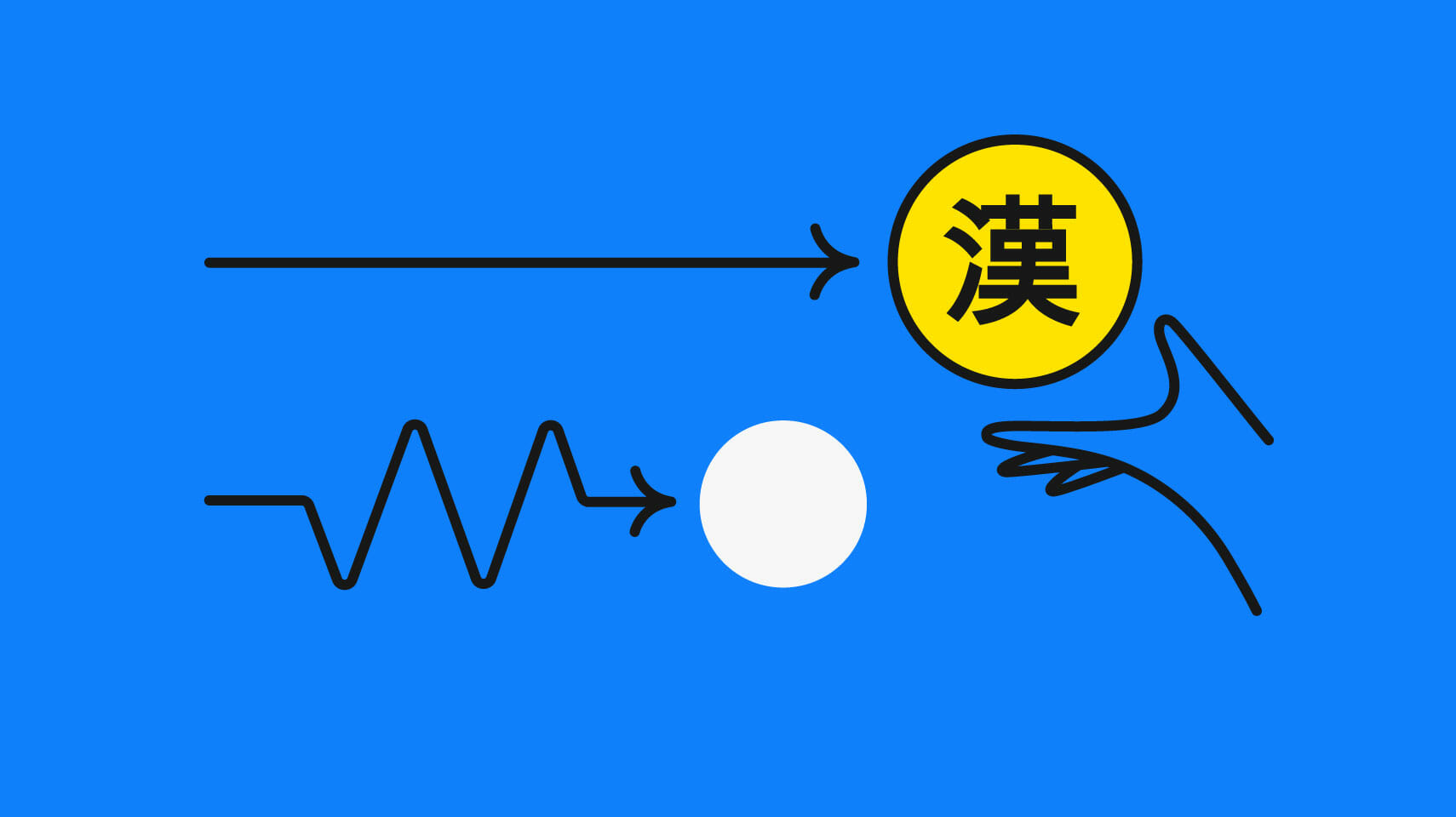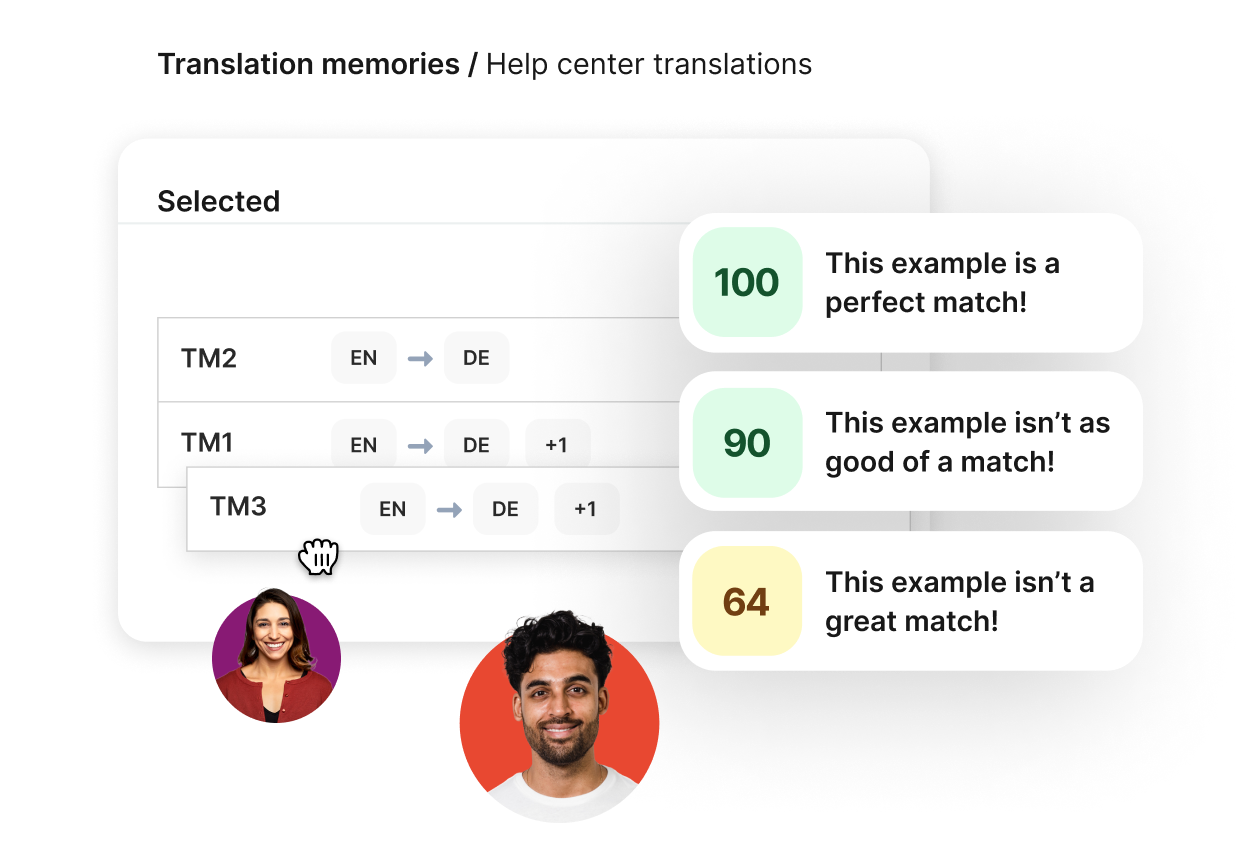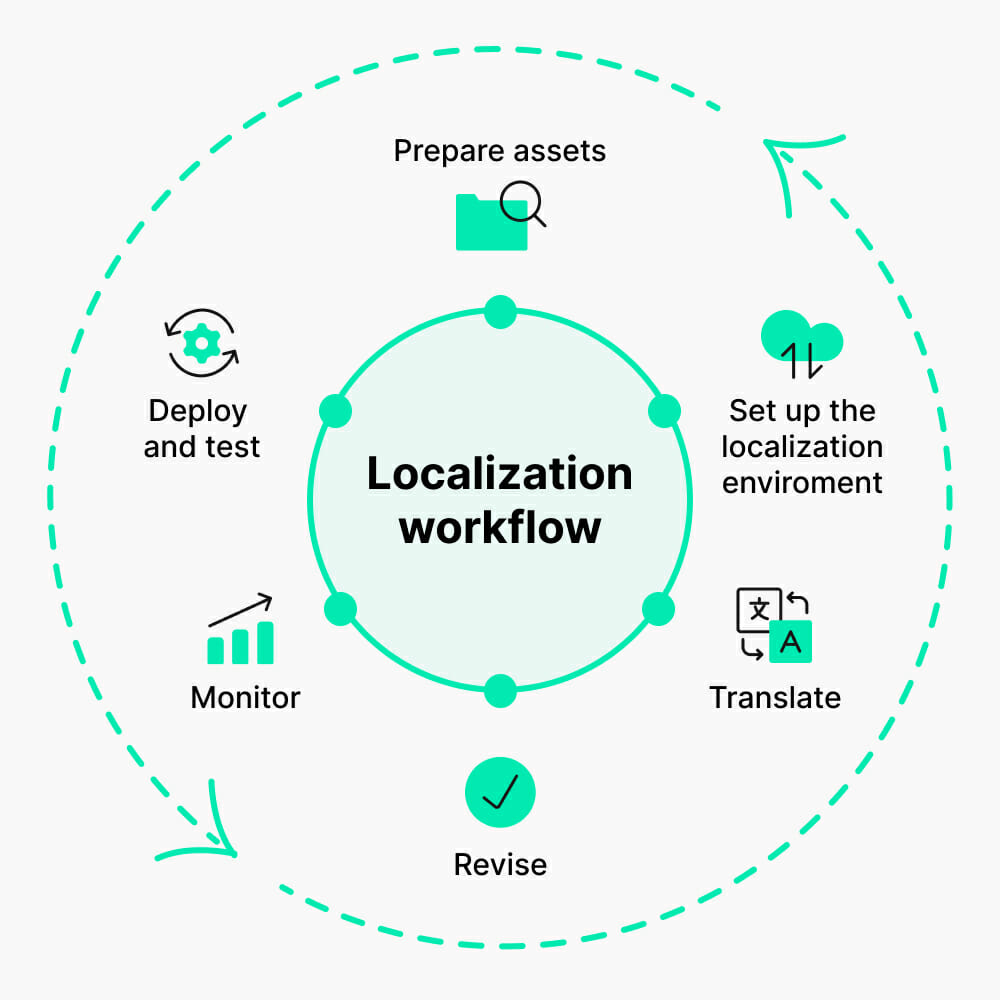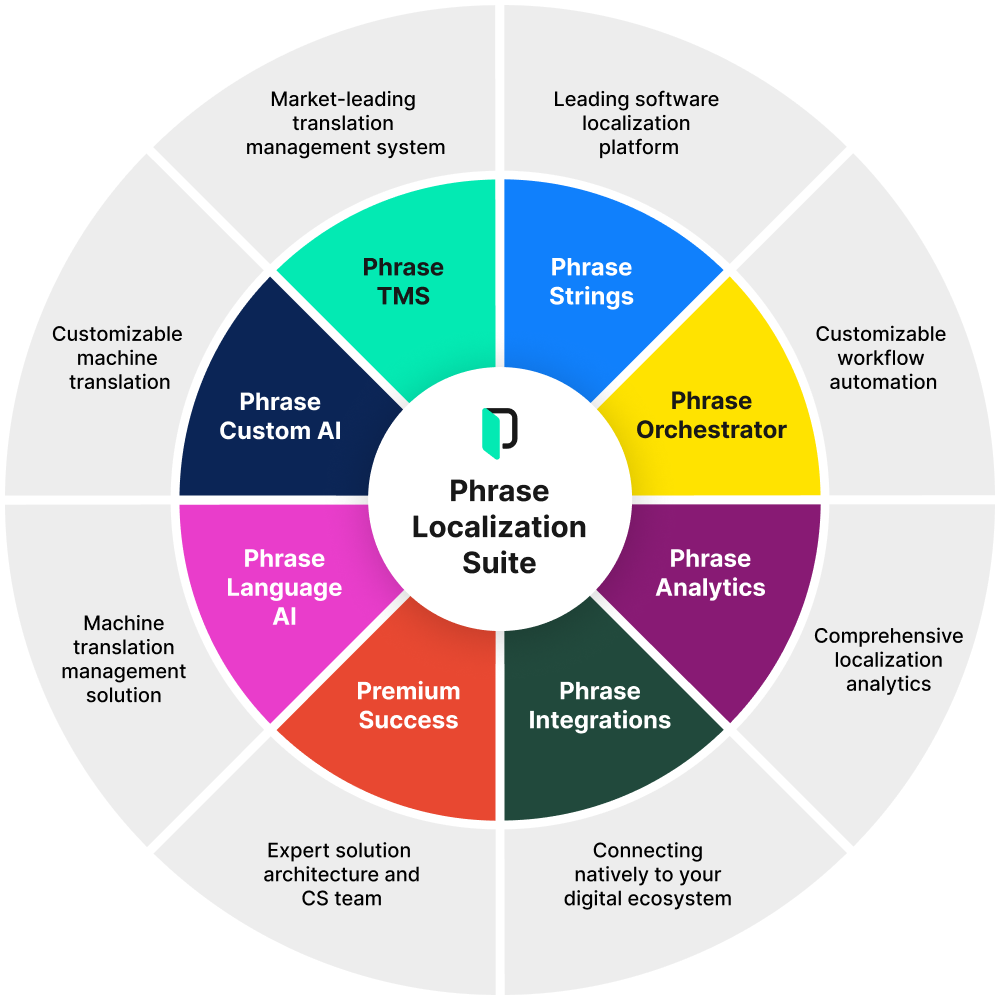Localization strategy
What Is The Best Translation Software and How to Leverage It for Global Expansion?

The invention of Gutenberg’s printing press in the 15th century changed the relationship between humans, technology, and information distribution forever. A couple of centuries later, computers started to facilitate translation between languages and spurred the development of machine translation technology.
Fast-forward to today, and you’ll see that language translation software has advanced to a critical tool for companies looking to expand the global footprint of their business. Keep reading to learn what makes translation software, what benefits it offers, and how to select the best one for your global strategy.

The right translation software for your needs
Drive global growth by automating, managing, and translating all your content with the world’s most powerful, connective, and customizable translation software.
What is translation software?
Translation software is any application that supports human translators in transferring text from one language to another. It’s designed from the ground up to improve the speed and quality of the translation process through automation.
Translation software usually comes in desktop and cloud versions. Tools for translation in the cloud have become more widespread over time—you can easily access them via a web browser anytime and from any device as long as you have an internet connection.
What types of translation software are there?
There are several types of translation software depending on the specific tasks each program is designed to handle:
- CAT tools: Computer-assisted translation (CAT) tools help translators break down a document into smaller segments (translation keys) to translate them efficiently.
- Machine translation software: Tools for machine translation (MT) use artificial intelligence to automatically transfer text between languages without any human input.
- Translation management systems (TMS): The most advanced type of professional translation software, combining CAT and MT tools with project management and business intelligence features.
How does translation software work?
The aim of any translation software is to improve the speed and quality of translation. To this end, these applications share some standard, off-the-shelf features that facilitate and optimize the work of translators. Let’s see how translation software works in practice, from project setup to delivery.

Project creation
If you decided to set up a project in a translation software application, the process would look something like this:
- First, you’d open your tool in your preferred browser and import the content that needs to be translated.
- Then, you’d select the language pairs and upload any complementary documentation relevant to the project, like additional guidelines or a specific term base.
- While setting up the project, you’d assign a translation manager as well as translators, editors, and proofreaders to work on specific components of the project.
Content analysis
Next, the content analysis process would take place, where the translation software would:
- Leverage a translation memory to highlight any terms or phrases that might have already been translated and suggest a translation for them—the translator can either accept it or apply any necessary edits.
- Grow the translation memory with any new terms or phrases—the more translations go through the software, the better your translation memory will work, and the faster your future translations will be.
- Show any term base hits that might appear in the content and suggest a translation for them—the software will also show any further information in the term base, such as an example of usage in context.
Translation and editing
Then, the translation process and review would begin, where translators, editors, and proofreaders can collaborate with each other in the same project to produce the best possible result.
Whether the project involves 100% human translation or a combination of MT and human work, translation software makes it easier to obtain a high-quality output. With an easy-to-use editor that’s context-rich (automatically captured UI screenshots, term bases, feedback from other stakeholders, etc.), linguists have all the necessary resources available in one place.
Review and quality assurance
After the translation is complete, there’s an automated quality assurance step. The software will run a series of checks on the content to ensure accuracy and compliance with your organization’s standards, like character count or terminology usage.
Then, an internal review and approval step normally follows to make sure the content is fit for publishing. Translation software allows for multiple stakeholders, such as project managers, designers, developers, marketing specialists, or other domain experts to review the content from one central location, providing feedback quickly and easily.
Delivery
Finally, you’d be able to download or export all the translations from your tool in the same format as the original copy and proceed with its distribution or publication. If the translation software has existing connectors or integrations available, you can export the translation directly to your content management system (CMS) or other tools you may be using.
Common translation software features
The core of any translation program are traditional CAT tools—primarily translation memory, term base, style guides, and other reference materials. Depending on the provider, modern translation software can also come with team management, quality assurance, and machine translation tools.
Translation memory
Translation memory is an essential component of any translation software. It removes the need to translate text that has already been translated. When you work on the same or similar segment of text, the tool will recommend an existing translation for that piece of text, which you can decide whether or not to use.
Likewise, if you are making minor updates to content like manuals or user guides, you can save both time and money by translating only the new text instead of the whole document. This is particularly useful for highly regulated industries like finance or law, where consistency and accuracy in terminology are paramount.
Term base (translation glossary)
A term base is an enhanced version of a dictionary where your translation software houses a database of single or multi-word terms along with their definition, use cases, and translation in one or several languages.
You can use your existing term base or upload a new one, especially if there’s specific terminology you’d like to use throughout the project. Term bases are important as they help your translators keep the text consistent across the board and avoid any misspellings or inaccurate use of terminology.
Style guide
Providing as much context as possible to your translators is essential for promoting accuracy and a higher quality of work. With many translation programs, you can upload reference material such as style guides or any other reference file that can help make informed decisions when translating a piece of text.
It’s also a good idea to check that the software lets you upload multiple reference files at once—crucial for large projects—and supports various types of documents. Bonus points if the software has a text-input function to type notes in each translatable segment, for those times when a quick comment will do the trick.
Team management
If you’re a business looking to expand into new markets, it’s very unlikely that you’d be working with a single translator. More often, a team of translation managers, translators, proofreaders, and editors will be assigned to different parts of the project. To make sure they’re on the same page and deliver quality results on schedule, they need to collaborate across time and space.
Modern translation software comes with a collaborative function where project members (e.g., translator, proofreader, project manager, etc.) can log in to the platform, see the latest status of the project, share comments, and assign tasks without needing to copy and paste any text or send attachments outside the platform. Since all project-related content is kept within the tool, all stakeholders enjoy effective collaboration, fast communication, and maximum data security.
Quality assurance tools
The legendary Mitt Romney gaffe of misspelling America in his presidential election campaign slogan “A Better Amercia” is testament to how important it is to follow quality assurance procedures prior to the final publication of any content.
Proper spelling and formatting of your branded content are the bare minimum customers expect before they engage with your products. The best translation software will have quality assurance as second nature to the overall translation process and protect you from any mishaps.
While translators can rely on their attention to detail to make sure the translated text is accurate, errors might happen in formatting, punctuation, or simply spelling of the text. Quality assurance systems will flag up any such mistakes and recommend solutions to ensure the text between the source and target text is consistent both in message and format.
Machine translation capability
Machine translation is increasingly becoming a standard component of modern translation software. It allows for the automatic translation of content without any human intervention—with speed and cost efficiency as its core benefits.
Machine translation works very well as a stepping stone to a translation project. It’s particularly useful for large quantities of content that may be repetitive or don’t require precision or creativity, e.g. technical documentation or user-generated content that can be translated automatically and post-edited by human translators for accuracy and consistency. This can help you deliver projects faster and maintain quality at a fraction of the cost you would have to pay if the project was translated manually.
Benefits of using translation software
Any business that is looking to expand beyond their local market needs to think about how they would position their products in other countries or regions. Frequently, a single country can have multiple official languages, and you need to translate your content in all of them to serve the different communities living there.
When you need to handle several languages and scores of translators, things can easily get out of hand. Using translation software can streamline the process by keeping all translation files centralized and helping you easily oversee the progress of your translation projects to ensure timely delivery.
Among the benefits translation software provides, you can expect:
Greater consistency
Translation projects are rarely done in isolation, and it’s likely that you’ll have several in-house and freelance translators (usually across different regions and time zones) writing and editing translations. Despite your utmost efforts to hire the best talent and give them clear instructions, it’s almost guaranteed that translators will use slightly different terminology to describe the same thing unless there is a system that keeps them in check.
Employing a translation program can remove this risk by giving translators the same translation memory and term base to work from. So, next time they come across a technical phrase or a term specific to your brand, you can rest assured that they’ll all remain consistent across your content.
Increased productivity
If you type emails regularly, chances are you’ve been in the situation of typing up an email only to realize that you wrote something very similar only a few days ago. If that’s the case, you probably wished the system prompted you to reuse the same text instead of typing it anew. Something very similar happens with translation projects where similar content reappears in contracts, website copies, or product descriptions.
Instead of having to translate it all over again—wasting time and risking inconsistency—a translation program can recall the existing translation of the same text, thus saving you time and money. Translators can review the existing translation and only spend time on edits and fine-tuning the content. They can use the rest of the time to work on other projects or translations, thus increasing their productivity.
More flexibility
When several translation projects run slightly differently—due to different content, target languages, file formats, or other factors—it can be difficult to set up and manage different workflows for each project.
A good translation software comes with standard and customizable workflows that you can tweak based on your needs and make sure all team members work off the same “playbook.”
Not to mention that cloud-based translation software tools are accessible from any device without the need to install licenses or to work from a single device. This allows your staff flexibility to work wherever and whenever they want without the risk of losing or misplacing files.
Improved quality
When uploading and sharing translation files, it’s very easy to encounter errors with formatting or the rendering of the design of the final translation. This can cause inconsistencies in the look and feel between the original and translated product, which, in turn, can undermine your brand reputation. Quality also relates to the accuracy of the translation itself, as any typos, untranslated sections, inconsistent wording, or poor grammar can negatively affect customer perception of your brand.
In this context, a translation program serves as a one-stop shop for quality assurance. For example, you can upload, translate, and download a file from the same tool while keeping the format and design of the document intact. You can also automatically identify any untranslated sections, spelling mistakes, and consistency issues, and the ability to preview the translation in context in real time helps detect any potential errors that may have otherwise gone unnoticed.
Finally, when your translation needs to leave the translation software for further work by other departments or for publishing on your website, a translation tool that offers out-of-the-box integrations or comes with an API can come in very handy for ensuring quality. For example, an integration with your design program lets translation software take automatic UI screenshots that it can then serve to translators as added visual context.
Reduced costs
It might be counterintuitive to think that buying translation software can save you money, but it’s all to do with the scale of your operations. If you’re going to translate only a handful of documents in the existence of your business, then a translation program might not be necessary.
However, it’s likely that you’ll have many applications, websites, manuals, and product descriptions to translate into one or several languages. Managing the logistics of such an enormous project can easily cost you hundreds of thousands of dollars if you don’t invest upfront in streamlining your translation operations.
Say, for example, you’ve launched a product update and you want your instruction manuals and user guides to reflect that. Instead of having to do the work all over again, a translation program can highlight which parts of the guides have been updated, telling the translator exactly what they need to work on. This single capability in itself can save you hundreds by removing the need to pay for the translation of the whole document.
Why using professional translation software is important for global business
Today’s global consumers expect to experience brands in their own language and their own cultural context. To keep up with this demand for continuous multilingual content delivery that caters to these needs, devising a smart, efficient translation process is key.
Translation software enables businesses to manage the entire translation process with fewer costs, increased quality, and a level of flexibility that’s often not doable with manual solutions. Translation software makes it easier to:
Speed up time to market
Any business that aims towards global expansion faces fierce competition and needs to act fast to stay ahead. When you launch the product is just as important as where. If your go-to-market strategy suffers because of delays in your translation efforts, you can rest assured that a valuable market share will go to your competition.
In this scenario, the efficiencies that a translation program enables will speed up the translation process and help you get to market in a shorter time with a product that resonates with your new market. The faster you can get your product translated—without undermining quality—and out to the public, the more opportunities you’ll have to capture new customers.
Maintain global brand consistency
Translation software helps you ensure that the content you’re sending out to each market is consistent with your brand’s overall style, messaging, and tone of voice—without compromising your adaptation to local market trends and expectations. It does so through the features we’ve mentioned above, like translation memories, term bases, and the possibility to include additional reference material such as style guides.
Your brand’s reputation will benefit from such attention to detail—a company that’s delivering content with a consistent voice and look inspires trust, loyalty, and repeat purchases.
Free up resources for other goals
We’ve addressed how translation software can significantly contribute to reducing translation costs by eliminating many manual tasks and speeding up workflows. There is, however, an added way in which leveraging translation software can reduce costs and let you use your resources for other, more strategic tasks: the use of machine translation as a productivity booster.
Machine translation can’t replace human translators in all use cases and language pairs yet, but employing it as part of your arsenal can help you get the job done faster, while still delivering high-quality content. For example, you can use it to pre-translate large volumes of repetitive, low-stakes content, leaving it to the professional translator to refine it with post-editing.
In this way, you can free up some of your resources for other projects such as innovating on the product or building the brand to grow across markets. When you can do more of the type of work that was previously not doable due to resource constraints, the associated benefits are also a by-product of using translation software to its full potential.
Scale up effortlessly
As you expand into more countries or introduce new products or services, translation software can help you scale up operations with minimal resources.
When you automate tasks like content flow through the translation cycle, stakeholder communication, report generation, and quality assurance, you’ll be able to handle more projects and languages with fewer people and resources.
Grow global revenue
The main reason any company decides to go global in the first place is to grow revenue. And every moment you aren’t reaching out to a potential customer in their language is potential revenue you’re losing.
We’ve discussed how translation software speeds up time to market and does wonders for your reputation. Revenue is the natural outcome of these two combined. The faster you can bring a product to new markets, the sooner customers will start buying it. And with consistent, high-quality translations that accurately convey your brand voice, your customers’ experience across markets will hold buyers and keep them coming back.
Looking for the best translation software? Power up your translation game with Phrase
To achieve all of the above, companies used to need a combination of technologies that would allow them to manage all aspects of the translation process without any friction. With the Phrase Localization Platform, however, looking for individual solutions is a thing of the past.

Phrase brings together all the essentials for successful international expansion. It’s an end-to-end solution that will help you go global quickly, accurately, and with minimal effort through:
- An enterprise-ready translation management system, Phrase TMS
- A highly integratable software localization platform, Phrase Strings
- Versatile add-ons to take your localization workflow to the next level:
- Phrase Orchestrator—a workflow automation editor
- Phrase Language AI—a machine translation management add-on for Phrase TMS
- Phrase Analytics—an analytics and reporting add-on for Phrase TMS
Companies worldwide rely on the Phase Localization Suite to automate their translation processes, improve time to market, and achieve consistent translations across channels and products by leveraging:
- A fully-featured CAT tool with a visual editor and real-time previews of translated content
- Translation memory to keep you from translating the same work twice
- Term base capabilities to help translators stick to your preferred terminology
- Automated translation quality assurance to keep translations accurate and consistent
- 30+ integrations with popular tools and platforms to speed up workflows
- Professional translation services in one click
- Robust security features to ensure secure data storage and transmission
Phrase is the best choice of translation software for enterprises looking to streamline their global operations through effective and efficient translation.
Speak with an expert
Want to learn how our solutions can help you unlock global opportunity? We’d be happy to show you around the Phrase Localization Platform and answer any questions you may have.





